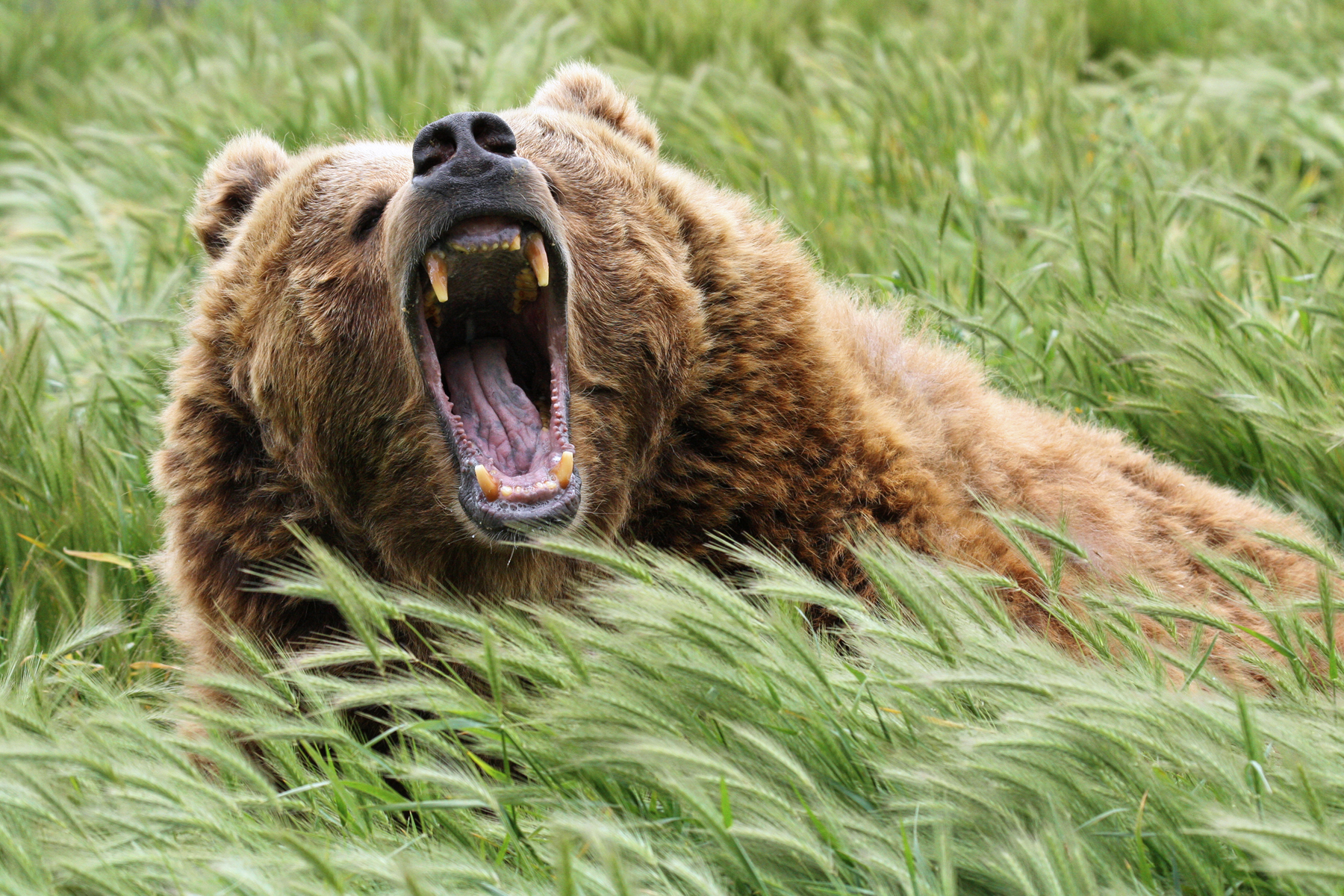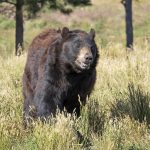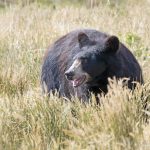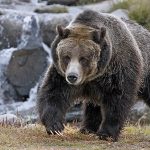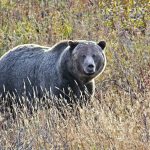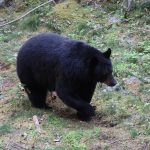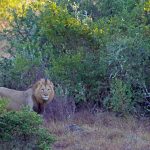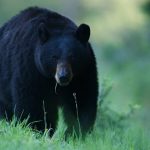Photo by Vic Schendel
It’s every hunter’s nightmare: A bear is crashing toward you through the brush. What should you do?
You are hunkered in a small, high-mountain clearing, calling for early season elk. Suddenly there is a crashing noise and a grizzly bursts from the brush, running straight for you. Do you rise and shout at the bear, or do you stand your ground? If the bear knocks you down, do you play dead or fight back?
Or: You see a sow with cubs approaching, about 150 yards away. She hasn’t noticed you, yet. Looking around, you see a very climbable tree a few feet away. But you’ve read the basic bear safety advice, which advises against climbing a tree in a griz situation. You’ve also read that grizzlies will go up trees to pull a person down for a mauling. You have a rifle for self-defense, and there is no inconspicuous way to leave the area. The sow and cubs are still heading your way. Should you climb the tree?
Or: You come around a bend in the trail and there’s a grizzly sixty feet ahead. It sees you and charges. You have your rifle at port arms, and there’s bear spray in a hip holster. Should you shoot the bear or try to spray it?
Or: A large griz, probably a dominant male, is fifty yards away, walking straight toward you. You aren’t sure if it has seen you or not, but it keeps coming. Should you stand your ground or back away? Should you yell and wave your arms?
Or: A bear comes into camp. Do you shout at it and act aggressive, or do you stand still and talk to the animal in a calm voice?
Or: You and your partner are charged by a bear. It knocks your partner down and begins mauling him or her. Should you try to shoot the bear with your rifle or handgun? Would it be better to blast the animal with pepper spray?
None of these scenarios are fanciful. All of them are based on one or more actual case histories or personal experiences. If you truly know the finer details of grizzly protocol, you should have a clear sense of how to deal with each of these situations. Unfortunately, most basic bear-safety info is contradictory, often ambiguous, and far too generalized.
A blatant example, which I hate to even quote because I don’t want to put it into anyone’s head, is the advice given by some state agencies for those encountering a bear: “If it’s black, fight back; if it’s brown, lie down.” The meaning is that one should “play dead” if attacked by a grizzly, and fight back if attacked by a black bear. But the maxim is both misleading and dangerous. First of all, there are black grizzlies and brown black bears. Color is not a distinguishing criterion. Second, there are times when you should definitely not play dead with a grizzly. Third, when to play dead with an appropriate bear is hugely important. Too soon, and you can encourage an attack that might otherwise not have happened; too late, and you can get more severely injured than might have been necessary. (You want to drop into a protective position just before the bear makes actual contact.) So the basic advice of playing dead in certain situations is OK, but as with so much other bear-safety lore, we have to go beyond the basics to reach a level of understanding that’s actually effective in griz country.
Good bear-safety advice is less about absolute or simplistic rules and more about playing to probabilities. If you shout and violently wave your arms at a suddenly met, close-in sow with cubs, the probability of getting charged or even attacked goes way up. If you do everything right (stand still, don’t lock eyes with the bear, talk to it calmly if there’s time while getting your spray or weapon ready for deployment), the probability of getting mauled lowers, even if the bear does elevate your heartbeat with a bluff charge.
Dealing with a Charge
And what if a grizzly does charge? This is probably the scenario we read or hear about most in the media–a hunter surprises a griz at close range and the bear “attacks.” (I use
quotation marks because, with grizzlies, a charge
is not an attack unless the bear actually hits you.) A charge can be a fearful and addling event. It can happen so fast and unexpectedly that, unless you’ve rehearsed, planned, and trained for it–and sometimes even if you have–the shock is unnerving and brain-numbing. It can make normally stolid individuals do very unadvisable things, like take off running in panic. Importantly, however, not all charges are the same.
“There are two kinds of aggressive charges,” the late biologist Charles Jonkel told me years ago in a taped interview. “There’s the bluff behavior. Sub-adults and some other individual bears will come at you with their feet wide apart, their fur fluffed up, and they come at you stiff-legged. They make a lot of noise, huffing. They come straight at you, and the head and ears will be up. They’re putting on a hell of an act. But they won’t come all the way. It’s a bluff.”
What Chuck suggested next is way beyond the basics: “In this case you face them down; do the same thing back to them. Raise your arms and huff right back at them. A person can look pretty formidable, especially when wearing a big coat. You can open the coat out to look bigger. There are times when you want to back them down. Look as big as you can, get a very firm voice, even a growling-type yell.”
Another top biologist believes it’s probably safer (for non-experts) to take a firm, but less assertive approach with bluff-charging bears. “Stand your ground, look them straight in the eye. Don’t back away; that only encourages an advancing bear. Don’t wave your arms violently. Don’t play dead. And never turn your back to the bear.”
While doing any of this, you should also have your bear spray or weapon out, ready to use, just in case.
As for the second kind of charge, Jonkel said: “When a bear’s really coming for you, it’s different. If it has its head down and ears laid back, it’s probably going to keep coming.”
One question for a hunter with a gun is: How do I know when to shoot a charging bear in self-defense, or if I should shoot?
The great advantage of bear spray is that you have much less of a dilemma. If the grizzly, whether bluff-charging or coming in hard for an attack, gets within thirty feet, you press the trigger and blast a strong cloud of pepper spray into its face. That usually (but not always) ends the confrontation. The bear takes off, uninjured. With gun-defense only, the stakes are higher. If you shoot too soon (which is common), you wound or kill a grizzly that probably didn’t need to be shot. If you wait too long, you put yourself in greater danger. Watch the head and ear position and the directness of the charge. If the head and ears are up, and the bear is hesitating, bouncing, or stiff-legging, hold fire; if the head is low and the ears are back, and the bear is coming straight-on fast, maybe uttering a deep rumbling growl, you will probably have to shoot to defend yourself when the animal is forty feet away or closer. This is an unhappy choice, because sometimes even this kind of bear will break off the attack, stop or veer to one side when it’s only a few yards or feet away. But it would be unrealistic and unsafe to expect a hunter to hold fire to such an extreme last moment.
Bear at a Distance
A very different type of encounter that seldom gets much attention is when you see a griz at a distance and must figure out what to do to avoid trouble. Taking one of my scenario examples, a large bear, probably a dominant male, is fifty yards away, heading straight toward you, walking steadily. You aren’t sure if the bear has seen you or not, but it keeps coming. What do you do?
Hopefully you won’t make the very common mistake of yelling, “Hey bear!” while waving your arms over your head–“to alert the bear that you’re human,” as some agency guidelines advise. To me, that’s asking for trouble, and there are manycase histories where the yelling/arm-waving approach triggered an instant charge, even from bears 100 yards away or more. The better procedure (assuming there is no available safe exit), is to prepare your deterrent or weapon, stand so that you are clearly visible, and talk toward the bear in a calm, but not overloud, voice. There is no need for arm-waving; when the bear sees (and hears) you it will know you’re human. (Grizzly vision is better than formerly believed–nearly as good as human vision.) Odds are a bear in this situation will not attack or charge, especially a male or lone female. (A sow with cubs might be more prone to a defensive charge.) If the bear stands on its hind legs, that’s a sign of curiosity, not aggression. It’s getting a higher-angle look at you while sampling the air current for scent. If it keeps coming, stand your ground. Don’t back away unless the bear stops its forward movement. If backing away encourages the bear forward, stop and stand your ground. Talk to the animal in a normal voice.
“Say something reasonable to the bear,” Jonkel advised, “because that creates body language. I tell people to say exactly what you want the bear to do, and your body will act out the message.”
If the bear doesn’t get the message, or disagrees with it and suddenly makes a run at you, the previous advice on handling a charge applies.
In my second griz-in-the-distance scenario, there’s a sow with cubs 150 yards off, heading your way. She hasn’t seen you yet, and with the wind direction she isn’t going to catch your scent until she’s very close. Because of the terrain, there’s no feasible way to make a retreat or wide evasive move without being detected, but there is a very climbable nearby tree. Should you climb it?
I experienced this exact situation while elk hunting in the Cabinet Mountains of northwest Montana. I had a rifle and bear spray, but my thinking was: Why risk a shootout, or spray-out, with a mother griz when I can get up this tree and maybe avoid any violent conflict, or even a nervous face-off?
I was twenty feet up and solidly perched (rifle and spray at the ready, just in case) when I heard, then saw, the bears moving near. I stayed still and quiet as the animals came closer, the cubs bobbing, tussling, and gamboling around the mother bear, who had her nose working. Fifteen feet away she looked up, clearly saw me, regarded me briefly as if to say, “I know you’re there,” but showed no stress or agitation. I was a mute statue with a slightly averted gaze. (Locking eyes with a bear is a signal of aggression or dominance, and can potentially trigger a defensive grizzly like this sow into a charge or attack.) She and the cubs moved on by. I stayed in the tree for twenty minutes, then quietly worked my way back down and got on with the hunt–my senses much sharpened and heightened.
Later I mentioned this incident to one of my bear mentors, an experienced biologist who often makes a point of telling people not to climb trees to escape from grizzlies. He admitted to doing the same thing himself on several occasions. He said: “If you’re up in a tree before the bear sees you, and then she comes along and does see you up there, you’re probably fine. It’s very unlikely the bear will come after you. The thing you don’t want to do is run for or try to scramble up a tree after a bear has seen you. More often than not that will trigger a chase response and a possible attack.”
Biologist Steve Herrero adds the cautionary tale of a man in Alberta who climbed a tree to avoid a sow and cubs that were 100 yards away, but who then made the mistake of shouting at the bear, hoping to haze her off the trail. The sow charged instantly, tore fifteen feet up the tree and pulled the man down for a brief, injurious (but fortunately not fatal) mauling.
It’s rarely wise to intimidate a defensive bear, which is one that feels threatened in any way by your presence, or is protective of its young.
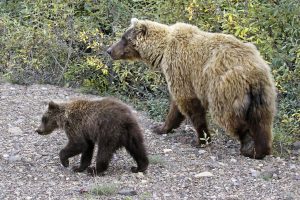
One of the most dangerous scenarios is encountering a female grizzly with cubs. It’s crucial not to act aggressively toward the bear in this situation. Photo by Vic Schendel
Bears on the Offensive
An offensive (or “non-defensive”) grizzly is a different matter. This is a bear that is seeking you out on purpose. It might be mistaking you for a prey animal (as when you’re calling game and perhaps wearing camo and masking scent); it might be moving in to scavenge an easy meal while you’re field-dressing game; it might come into camp looking for edibles, or it might (in rare instances) be tent-invading or hunting you as human prey.
In one of my scenarios a bear comes crashing into the clearing where you are using a game call for early season elk. This is an offensive bear, one seeking you out, probably because it has mistaken you for whatever your call represents (calf, cow, even a bugling bull elk). With this kind of bear your response should be very different from what it would be with a defensive sow-and-cub or carcass-defender. Ideally, you would stand (if there’s time), shout loudly, and blast the animal in the face with a full load of pepper spray. In some actual cases, just standing and shouting was enough to cause a startled bear to skid to a halt and reverse directions. (The bear was expecting a prey animal, not a large, aggressive human.) In other instances the grizzly was so locked in with predator intensity it kept coming and needed either a blast of spray or, less fortunately, a bullet, to startle it out of predator mode and into retreat (or death).
Whether or not there is time to deploy a weapon, a hunter attacked in this situation should not play dead, but should do whatever is possible to fight off the bear. (Using gun, knife, binocular, rock, kicks to the head, jabs to the eyes, etc.)
In most cases like this, when a bear realizes it’s tangling with a human and not a prey animal, it usually quits the attack and runs off, leaving the hunter wounded but alive.
Another offensive-grizzly scenario is a bear coming into camp. Do you yell at it, wave arms and act aggressively, or do you stand still and talk to the animal in a calming tone of voice?
Short answer: You yell at it, bang pans, throw things at it, maybe even try a warning shot in the air, or into the ground near the animal’s feet and face. Everyone in camp should group together to put up an intimidating, loud, startling front. If the bear is in range, you should hit it with spray, and all available firearms should be readied and aimed. If the bear comes at you or another person aggressively, and spray isn’t on hand or hasn’t worked, it’s lethal force time. This is more emphatically true with a night bear, especially one that is attempting to break into your tent (or has broken in). If you are ever attacked by a camp-invader or a night bear, never play dead; always fight back as hard as you can, with whatever you’ve got on hand.
Your Hunting Partner is Attacked
Final scenario: You and your partner are charged by a grizzly. It knocks your partner down and begins mauling him or her. Should you try to shoot the bear with your rifle or handgun? Or would it be better to blast the animal with pepper spray?
This has happened often over the years, and in more than a few cases, sad to say, the mauling victim has been killed not by the bear, but by the partner’s errant, well-intended bullet. However, in many instances a mauling bear has been driven off when a partner shot the animal in the face with pepper spray. So if spray is on hand, that should be the first weapon of choice. If a firearm must be used, it needs to be used up close. This is easy to say while sitting at a keyboard; not so easy in reality. A mauling grizzly is a furious creature, a terrifying one. I’ve never witnessed a human mauling (I have viewed several on video, which is awful enough), but I’ve seen adult bears fighting, and once saw a large boar maul and nearly kill a sub-adult. The power and violence and fury is shocking. So running up to a grizzly as it mauls your partner or family member is a sheer act of guts and courage.
With spray, you can shoot from ten to twelve feet (if you’re too close the spray doesn’t aerosolize as effectively), but with a firearm you need to get to point-blank range, where there’s little chance of accidentally hitting the mauled victim. With a gun you can try for whatever target is available–behind the upper foreleg (heart), the neck, skull, even the open mouth if the bear presents it. Often the shot need not be fatal to drive the bear away. Despite common belief, case histories show that far more often than not, a wounded grizzly will take off rather than continue or intensify an attack.
These last two scenarios show the inarguable value of hunting or hiking with a partner (or two) while in griz country. During any type of encounter, two humans present a more intimidating presence (from the bear’s perspective) than one. When game-calling or field-dressing a downed animal, one person can work the call or knife while the other stays alert, with spray or firearm at ready, scanning and listening for an approaching bear. In any instance where there is a serious charge, two weapons provide better odds of a successful hit. And as shown, in case of an actual attack, a partner can move in to stop the mauling and drive off the bear– and then provide aid and assistance for evacuation to medical help.
I can’t overemphasize the value of making a response plan for various types of encounters, such as those I’ve described, focusing on how you will react and what you will or won’t do in specific situations. As sports and military trainers often say, “If the mind has never been there before, the body will not know how to respond.”

